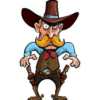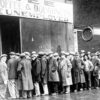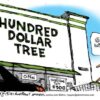Iron Eyes Cody
![]()
Iron Eyes Cody
(34) The Crying Indian – full commercial – Keep America Beautiful – YouTube

From Wikipedia, the free encyclopediaJump to navigationJump to search
| Iron Eyes Cody | |
|---|---|
| Cody (left), Glendale, California at Charles Wakefield Cadman‘s funeral, 1947 | |
| Born | Espera Oscar de Corti April 3, 1904 Kaplan, Louisiana, U.S |
| Died | January 4, 1999 (aged 94) Los Angeles, California, U.S |
| Resting place | Hollywood Forever Cemetery |
| Other names | The Crying Indian |
| Years active | 1927–1987 |
| Spouse(s) | Bertha Parker(m. 1936; died 1978) Wendy Foote(m. 1992; div. 1993) |
| Children | 2, including Robert Tree Cody |
| External images |
|---|
Iron Eyes Cody (born Espera Oscar de Corti, April 3, 1904 – January 4, 1999) was an American actor of Italian descent who portrayed Native Americans in Hollywood films,[2] famously as Chief Iron Eyes in Bob Hope‘s The Paleface (1948). He also played a Native American shedding a tear about litter in one of the country’s most well-known television public service announcements from the group Keep America Beautiful.[3] Living in Hollywood, he began to insist, even in his private life, that he was Native American, over time claiming membership in several different tribes. In 1996, Cody’s half-sister said that he was of Italian ancestry, but he denied it.[3][4] After his death, it was revealed that he was of Sicilian parentage, and not Native American at all.[2][3][4]
Contents
- 1Early life
- 2Career
- 3Personal life and death
- 4Honors
- 5Partial filmography
- 6Bibliography
- 7See also
- 8References
- 9External links
Early life[edit]
Cody was born Espera Oscar de Corti on April 3, 1904, in Kaplan in Vermilion Parish, in southwestern Louisiana, a second son of Francesca Salpietra from Sicily and her husband, Antonio de Corti from southern Italy.[4] He had two brothers, Joseph and Frank, and a sister, Victoria.[2] His parents had a local grocery store in Gueydan, Louisiana, where he grew up.[5] His father left the family and moved to Texas, where he took the name Tony Corti. His mother married Alton Abshire and had five more children with him.[2]
When the three de Corti brothers were teenagers, they joined their father in Texas and shortened their last name from de Corti to Corti. Cody’s father, Tony Corti, died in Texas in 1924.[4] The brothers moved on to California, where they were acting in movies, and changed their surname to Cody.[6] Joseph William and Frank Henry Cody worked as extras, then moved on to other work. Frank was killed by a hit-and-run driver in 1949.[4]
Career[edit]
Cody began acting in the late 1920s. He worked in film and television until his death. Cody claimed his father was Cherokee and his mother Cree,[3] also naming several different tribes, and frequently changing his claimed place of birth. To those unfamiliar with Indigenous American or First Nations cultures and people, he gave the appearance of living “as if” he were Native American, fulfilling the stereotypical expectations by wearing his film wardrobe as daily clothing—including braided wig, fringed leathers and beaded moccasins—at least when photographers were visiting, and in other ways continuing to play the same Hollywood-scripted roles off-screen as well as on.[2][4]
He appeared in more than 200 films, including The Big Trail (1930), with John Wayne; The Scarlet Letter (1934), with Colleen Moore; Sitting Bull (1954), as Crazy Horse; The Light in the Forest (1958) as Cuyloga; The Great Sioux Massacre (1965), with Joseph Cotten; Nevada Smith (1966), with Steve McQueen; A Man Called Horse (1970), with Richard Harris; and Ernest Goes to Camp (1987) as Chief St. Cloud, with Jim Varney.Iron Eyes Cody and Roy Rogers in North of the Great Divide, 1950
He also appeared in over a hundred television programs.[7] For example, in 1953, he appeared twice in Duncan Renaldo‘s syndicated television series, The Cisco Kid as Chief Sky Eagle. He guest starred on the NBC western series, The Restless Gun, starring John Payne, and The Tall Man, with Barry Sullivan and Clu Gulager. In 1961, he played the title role in “The Burying of Sammy Hart” on the ABC western series, The Rebel, starring Nick Adams. A close friend of Walt Disney, Cody appeared in a Disney studio serial titled The First Americans, and in episodes of The Mountain Man, Davy Crockett and Daniel Boone. In 1964 Cody appeared as Chief Black Feather on The Virginian in the episode “The Intruders.” He also appeared in a 1974 episode of Mister Rogers’ Neighborhood featuring Native American dancers.
Cody was widely seen as the “Crying Indian” in the “Keep America Beautiful” public service announcements (PSA) in the early 1970s.[8] The environmental commercial showed Cody in costume, shedding a tear after trash is thrown from the window of a car and it lands at his feet. The announcer, William Conrad, says: “People start pollution; people can stop it.” The ad won two Clio awards, incited a frenzy of community involvement, and “helped reduce litter by 88% across 38 states”, according to one reliable source.[7] Cody was a participant in the documentary series Hollywood (1980), where he discussed early Western filmmaker William S. Hart‘s use of Native American Sign Language.[9]
The Joni Mitchell song “Lakota”, from the 1988 album, Chalk Mark in a Rainstorm, features Cody’s chanting.[10] He made a cameo appearance in the 1990 film Spirit of ’76.
Personal life and death[edit]
In 1936, Cody married archaeologist Bertha Parker. She was active in excavations during the late 1920s and early 1930s before becoming an assistant in archaeology at the Southwest Museum.[11] They adopted two children said to be of Dakota–Maricopa origin, Robert Tree Cody and Arthur. The couple remained married until Bertha’s death in 1978.
Although the non-Native public who knew him from the movies and television thought of Cody as an American Indian, a 1996 story by The Times-Picayune in New Orleans questioned his heritage, reporting that he was a second-generation Italian-American. This was based on an interview with his half-sister, and documents including a baptismal record. Cody, who now wore his Hollywood costumes in daily life, denied the claim.[3][4]
Cody died at the age of 94, due to a mesothelioma at home in Los Angeles on January 4, 1999.[3] Before death, he had written this comment: “Make me ready to stand before you with clean and straight eyes. When Life fades, as the fading sunset, may our spirits stand before you without shame”.[7]
Honors[edit]
On April 20, 1983, he was inducted to the Hollywood Walk of Fame at 6601 Hollywood Boulevard.[5]
In 1999, a Golden Palm Star on the Palm Springs, California, Walk of Stars was dedicated to him.[12]
Partial filmography[edit]
| Year | Film | Role | Notes |
|---|---|---|---|
| 1927 | Back to God’s Country | Indian | Uncredited Role |
| 1928 | The Viking | Indian | Uncredited Role |
| 1930 | The Big Trail | Indian | Uncredited Role |
| 1931 | Fighting Caravans | Indian After Firewater | Uncredited Role |
| 1931 | Oklahoma Jim | War Eagle | |
| 1931 | The Rainbow Trail | Indian | |
| 1932 | Texas Pioneers | Little Eagle | |
| 1942 | Ride ‘Em Cowboy | Indian | Uncredited Role |
| 1947 | The Senator Was Indiscreet | Indian | |
| 1947 | Unconquered | Red Corn | |
| 1947 | Bowery Buckaroos | Indian Joe | |
| 1948 | Blood on the Moon | Indian | Uncredited Role |
| 1948 | The Paleface | Chief Iron Eyes | |
| 1948 | Indian Agent | Wovoka | |
| 1949 | Massacre River | Chief Yellowstone | |
| 1950 | Broken Arrow | Teese | Uncredited Role |
| 1951 | Ace In The Hole | Indian Copy Boy | Uncredited Role |
| 1952 | Lost in Alaska | Canook | Uncredited Role |
| 1952 | Montana Belle | Indian on horseback | Uncredited Role |
| 1954 | Sitting Bull | Crazy Horse | |
| 1955 | White Feather | Indian Chief | |
| 1958 | Gun Fever | 1st Indian Chief | |
| 1965 | The Great Sioux Massacre | Crazy Horse | |
| 1966 | Nevada Smith | Taka-Ta | Uncredited Role |
| 1970 | El Condor | Santana, Apache Chief | |
| 1970 | Cockeyed Cowboys of Calico County | Crazy Foot | |
| 1970 | A Man Called Horse | Medicine Man #1 | |
| 1977 | Grayeagle | Standing Bear | |
| 1987 | Ernest Goes to Camp | Old Indian ‘Chief St. Cloud’ | Final film role |
| Year | Title | Role | Notes |
|---|---|---|---|
| 1953 | The Cisco Kid | Chief Big Cloud / Chief Sky Eagle | Two separate roles, Indian Uprising (1953) as Chief Sky Eagle and The Gramophone (1953) as Chief Big Cloud |
| 1955 | Cavalcade of America | n/a | Episode, The Hostage (1955) |
| 1958 | The Restless Gun | George Washington Smith | Episode “A Pressing Engagement” |
| 1959 | Rawhide | John Redcloud | Episode, Incident of the Thirteenth Man (1959) |
| 1959 | The Lucy-Desi Comedy Hour | Eskimo Pilot | Episode, Lucy Goes to Alaska (1959) |
| 1959 | Mackenzie’s Raiders | n/a | Episode, Death Patrol (1959) |
| 1961 | The Rebel | Sammy Hart | The Death of Sammy Hart (1961) Season 2, Episode 25 |
| 1961 | Dick Powell’s Zane Grey Theatre | Nemanna | Episode, Blood Red |
| 1962 | Mister Ed | Chief Thundercloud | Episode, Ed the Pilgrim (1962) Season 3, Episode 9 |
| 1964 | The Virginian | Chief Black Feather | Episode, The Intruders (1964) Season 2, Episode 23 |
| 1967 | The Fastest Guitar Alive | 1st Indian | |
| 1969 | Then Came Bronson | Chief John Carbona | Episode, Old Tigers Never Die—They Just Run Away (1969) |
| 1983 | Newhart | Hotel Guest | Episode, Don’t Rain on My Parade (1983) |
| 1986 | The A-Team | Chief Watashi | Episode, Mission of Peace (1986) |
Bibliography[edit]
- Indian Talk: Hand Signals of the American Indians, 1970, 1991, Naturegraph Publishers, Inc. ISBN 0-911010-82-3
See also[edit]
References[edit]
- ^ “Official diary” (PDF). www.jimmycarterlibrary.gov. Retrieved March 27, 2020.
- ^ Jump up to:a b c d e Mikkelson, Barbara (August 9, 2007). “Was Iron Eyes Cody an American Indian?”. Snopes.com.
- ^ Jump up to:a b c d e f Waldman, Amy (January 5, 1999). “Iron Eyes Cody, 94, an Actor And Tearful Anti-Littering Icon”. The New York Times.
- ^ Jump up to:a b c d e f g Aleiss, Angela (May 26, 1996). “Native Son: After a Career as Hollywood’s Noble Indian Hero, Iron Eyes Cody is Found to Have an Unexpected Heritage”. The New Orleans Times-Picayune.
- ^ Jump up to:a b “Iron Eyes Cody – Hollywood Walk of Fame”. www.walkoffame.com. Retrieved September 12, 2018.
- ^ George De Stefano (January 23, 2007). An Offer We Can’t Refuse: The Mafia in the Mind of America. Faber & Faber/Farrar, Straus, Giroux. pp. 279–. ISBN 978-0-86547-962-3.
- ^ Jump up to:a b c “The True Story of ‘The Crying Indian'”. Priceonomics.
- ^ “Pollution: Keep America Beautiful – Iron Eyes Cody”. Ad Council. Retrieved August 20, 2015.
- ^ “Out West”. Hollywood. Episode 9. March 4, 1980.
- ^ Walker, Chris J. (June 1, 2002). “Larry Klein Is Doing It All”. Mixonline.com. Archived from the original on March 8, 2014.
- ^ “Verdugo Views: The true story of Iron Eyes Cody”. August 28, 2014 – via LA Times.
- ^ “Palm Springs Walk of Stars – Listed by date dedicated” (PDF). Archived from the original (PDF) on October 13, 2012.
External links[edit]
Portals:BiographyUnited StatesCaliforniaFilmTelevision
- 20th-century American male actors
- American male film actors
- American male television actors
- Male Western (genre) film actors
- American people who self-identify as being of Native American descent
- American people of Italian descent
- Impostors
- Male actors from Louisiana
- People from Gueydan, Louisiana
- People from Kaplan, Louisiana
- Deaths from mesothelioma
- Deaths from cancer in California
- Burials at Hollywood Forever Cemetery
- 1904 births
- 1999 deaths
Navigation menu
- Not logged in
- Talk
- Contributions
- Create account
- Log in
Search
Contribute
Tools
- What links here
- Related changes
- Special pages
- Permanent link
- Page information
- Cite this page
- Wikidata item
Print/export
In other projects
Languages
Lets keep our stream, and landscape forest free from trash so the little ones can play in a safe environment
And that the way I see cowboyron































![Lieutenant-Colonel Robert Rogers (7 November 1731 – 18 May 1795) was a British Army officer and frontiersman. Born in Methuen, Massachusetts, he fought in King George’s War, the French and Indian War and the American Revolutionary War. During the French and Indian War, Rogers raised and commanded Rogers’ Rangers, a ranger unit trained for carrying out asymmetric warfare.[2][3](https://www.cowboyron.com/wp-content/uploads/2022/05/1262463_580743685323360_2133853937_o1-1-150x150.jpg)

















![Billie Joe Armstrong & Norah Jones – Silver Haired Daddy Of Mine [Music Video]](https://www.cowboyron.com/wp-content/uploads/2022/11/Al_St._John1-100x100.jpg)



























